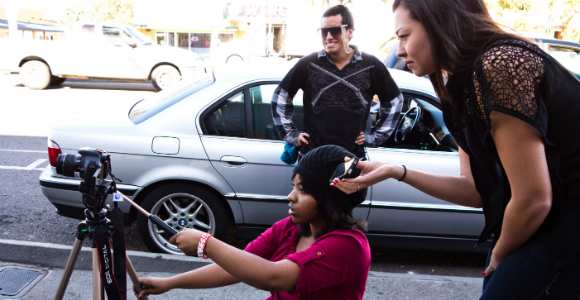
Media pathways program video shoot. (Photo Credit: Media Arts Center San Diego)
One of the most common misconceptions about the current economic climate is that there are no jobs available. Yet in reality, positions are open, and some employers are struggling to fill them. The real issue is that candidates are unqualified or under-qualified for the high-skilled and technical jobs that will fuel California’s continued economic growth.
Things could get worse before they get better if current economic and education trends continue. According to a new ReadyNation/America’s Edge report, recent data analyses suggest that, by 2025, California will face a deficit of 1 million workers with bachelor’s degrees to fill open jobs; another 1 million workers will be needed to fill middle-skill jobs requiring more than a high school diploma. Employers are not solely concerned with basic competencies in math, English and science, they are worried about candidates’ lacking interpersonal skills, and their ability to think creatively and work collaboratively.
It is no secret that the technology sector is growing fast. In fact, jobs in science, technology, engineering and math (STEM) are expected to grow by 22 percent by 2020. When compared with the overall job growth rate in California, which is 17 percent across all industries, it is clear that STEM jobs present a wealth of opportunities for students moving forward. Yet more often than not, workers need more training and education to be considered for these types of positions. It is estimated that 96 percent of STEM jobs available in California will require some form of postsecondary education by 2020, and 76 percent will require a bachelor’s degree or higher. Overall, by 2020, there will be 91 percent more job openings in California for those with some college education.
With numbers like these, you might expect today’s youth to be on the cusp of claiming the high-profile jobs in California’s tech industry. Yet the headlines – and the test scores – tell a different story. Only 29 percent of California’s eighth graders are proficient in reading, only 27 percent are proficient in math and only 22 percent are proficient in science. Additionally, one out of every five freshmen in California does not graduate within four years. Those who do graduate are often under-prepared only one-third of California graduates met college readiness benchmarks in English, reading, math and science.
Hope is not lost. Fortunately, an innovative education approach is gaining traction in classrooms throughout the state. By integrating rigorous academics with career-based learning and real world workplace experiences, Linked Learning is preparing students for future success in college and career. Linked Learning career pathway themes are closely aligned with the needs of regional economies.
For example, computer science and technology academies in Silicon Valley are preparing local students for careers in software engineering, among other high-tech industry options. Media arts pathways in Los Angeles equip students with the skill set they need to do digital production work in the film industry. Agriculture-themed academies in the Central Valley are preparing students for jobs in plant science and agriculture business management.
These sectors – and many, many others – make the Golden State thrive. Contrary to some false impressions, students are not pigeonholed into these pathways or even required to select their career at age 14. The goal of Linked Learning is to make education relevant so students stay engaged in school and understand why they need to know what they are being taught in the classroom.
As the eighth largest economy in the world, California must be ready and able to compete on a global level. State policymakers have stepped up in a big way by authorizing the California Career Pathways Trust, a one-time competitive grant program designed to create and support career pathway programs. The goal is to create stronger connections among regional employers, K-12 school districts and community colleges to generate pathways to high-skill, high-wage jobs and better prepare students for careers in California’s thriving industries.
Last week, 39 consortia representing schools and employers around the state became the first recipients of grants for the $250 million trust, which was established in the 2013-14 state budget by Senate President pro Tempore Darrell Steinberg. Unfortunately, $250 million was not enough to meet the demand. In all, the Department of Education received 123 eligible applications containing about $709 million in requested grants.
While many policymakers are taking an interest in Linked Learning, the real kudos go to the local employers and school leaders who put their heads together to draft collaborative career pathway plans that make the most sense for their regional economies. In order to keep pace with the demands for a more skilled and educated workforce, public and private employers are getting more involved with their local schools. Work-based learning opportunities such as job shadowing, mentoring students, internships, site visits and virtual assignments will go a long way toward preparing students for the high-demand jobs of the future.
This state investment combined with local support and partnerships will truly go a long way toward sustaining and growing California’s economy in the long run.
Jennifer Ortega is California State Director for ReadyNation/America’s Edge.

